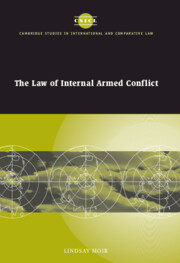Book contents
- Frontmatter
- Contents
- Preface and acknowledgements
- Table of cases
- Table of treaties and other international instruments
- 1 The historical regulation of internal armed conflict
- 2 Article 3 common to the Geneva Conventions
- 3 Additional Protocol II of 1977
- 4 Customary international law and internal armed conflict
- 5 Human rights during internal armed conflict
- 6 Implementation and enforcement of the laws of internal armed conflict
- Bibliography
- Index
- CAMBRIDGE STUDIES IN INTERNATIONAL AND COMPARATIVE LAW
6 - Implementation and enforcement of the laws of internal armed conflict
Published online by Cambridge University Press: 07 July 2009
- Frontmatter
- Contents
- Preface and acknowledgements
- Table of cases
- Table of treaties and other international instruments
- 1 The historical regulation of internal armed conflict
- 2 Article 3 common to the Geneva Conventions
- 3 Additional Protocol II of 1977
- 4 Customary international law and internal armed conflict
- 5 Human rights during internal armed conflict
- 6 Implementation and enforcement of the laws of internal armed conflict
- Bibliography
- Index
- CAMBRIDGE STUDIES IN INTERNATIONAL AND COMPARATIVE LAW
Summary
A considerable body of international law exists to protect civilians during internal armed conflict. The main problem lies not in the content of those rules, but rather in their enforcement. The enforcement of humanitarian law in international conflicts has been extensively studied, but much less has been written on how this is to be achieved where the conflict is not international in character. Neither common Article 3 nor Additional Protocol II contains provisions governing their enforcement. In fact, ‘The system as a whole has been devised for international conflicts; it cannot simply be switched over to non-international conflicts, whose basic data are completely different.’ Enforcement and implementation of the humanitarian laws of internal armed conflict will thus be examined in terms of (a) sanctions against lawbreakers, and (b) other means of securing compliance.
Sanctions against lawbreakers
Individual criminal responsibility
Enforcement measures against individuals alleged to have violated humanitarian law primarily entail their trial following hostilities. The clearest example is that of the Nuremberg Tribunal following the Second World War where many leading Nazis were tried for crimes against peace, war crimes and crimes against humanity. The trials at Nuremberg, and those of other war criminals since, have, however, tended to be concerned with violations of the laws of international conflict.
- Type
- Chapter
- Information
- The Law of Internal Armed Conflict , pp. 232 - 277Publisher: Cambridge University PressPrint publication year: 2002



